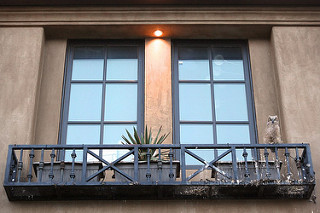
The nest is in a fiberglass planter box atop an iron planter ledge under upper story windows of the front our home in NW Oklahoma City. It is one of three planter boxes on the ledge, all of which are approximately 12” deep, by 12” tall, and 24” wide. They are filled with an organic mix of vermiculite, peat moss, and mushroom compost. This mix was chosen both for good growing conditions, as well as a healthy, chemical-free soil for the owls.
See the 2014 Nest News above for detailed info on lay, pip, and hatch dates.
It is said that the number of eggs laid a GHO is related to food supply. The better the food supply (mainly rodents, rabbits, and other small birds) the more potential eggs. It is likely that seasonal conditions this Summer and Fall led to a larger clutch of eggs this year than in prior years when the food supply was not as abundant.
Even though Egg 2 was laid 3 days after Egg 1, it pipped less than 24 hours after Egg1. This is 2 days sooner than average. Egg 1 hatched right on schedule, within 48 hours of pipping. After 48 hours from Egg 2's pipping, it had not hatched, nor did it show any sign of advancement, movement, or sound. All of these are evidence of an active hatch. With tens of thousands of viewers awaiting Egg 2's hatch, and over a thousand active chatters, many were asking questions of concern about Egg2. We conferred with our go-to experts behind the scenes and decided it was time to face the likely facts: that Egg2 was not going to hatch. We announced that it was likely unviable.
Later that night, Mrs. Tiger was exhibiting behavior similar to past hatches, and much to both our surprise and our viewers' Egg 2 had successfully hatched! Alessondra had chosen the name "Amur" as one of the possible names for this year's owlets. She decided it was the perfect name for Egg 2, and aptly nick-named it "Amuracle" because of its dramatic entrance into the wild.